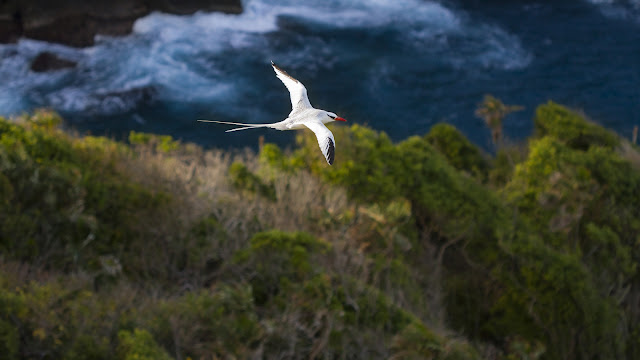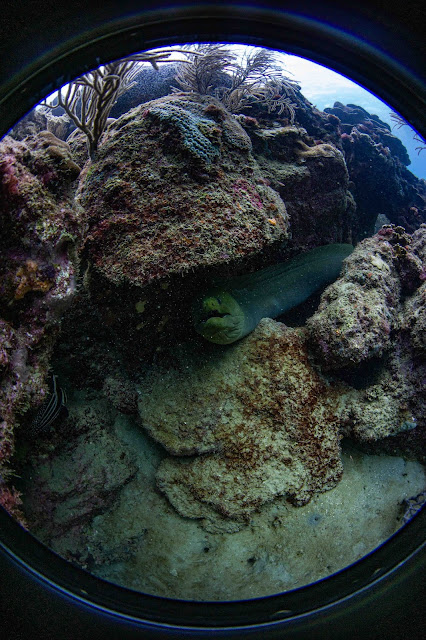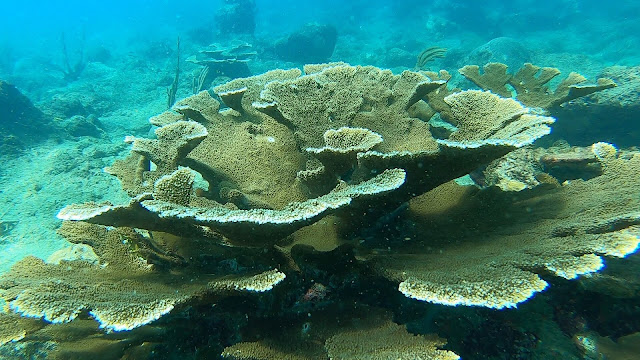Ocean wanderer Sargasso Shearwater
Faraaz Abdool puts the spotlight on the bird whose habitat is the mid-Atlantic and breeding ground the rocky islands off Tobago’s north.
The Sargasso Sea in the Atlantic is unique among all other seas as all its boundaries are oceanic. While the body of water itself was named after the ubiquitous sargassum seaweed found within it, there is a small, cryptic seabird that now carries this name: the Sargasso Shearwater. Its scientific name – Puffinus lherminieri - is in honour of the Guadeloupe-based French naturalist Félix Louis L’Herminier, who, with his son in his later years, spent considerable time studying the flora and fauna of the Caribbean.

An adult Sargasso Shearwater makes
its way to its burrow. Photo by Faraaz Abdool
Sargasso Shearwaters are pelagic birds, meaning that they are superbly adapted to life on the ocean. They are from the order of birds colloquially known as “tubenoses” which comprises four families of ocean wanderers: shearwaters, albatrosses, petrels, and storm-petrels. They are so named for their tube-encased nostrils laying on top of their bills. While all members of this group of seabirds have these distinctive tubes, they tend to be much more pronounced on the smaller species - which are also the species that typically nest in burrows. This correlates with an enhanced sense of smell that the birds use to locate their nests, and also to find plankton in what we perceive as a featureless ocean. Larger tubenoses such as the various species of albatross are typically surface nesters, and would build their nests in open areas. All tubenoses nest on remote, inaccessible offshore islands that are devoid of terrestrial predators.
Sadly, most of this group of seabirds are threatened with extinction. Whether by plastic ingestion, the presence of invasive predators on their breeding grounds, or by light pollution impacting their nocturnal breeding habits, these contemporary threats are an extension of our historically damaging relationship with them. While tubenoses in general have a cosmopolitan distribution, some of the individual families are limited to specific regions. All of them, however, are wholly dependent on a life at sea.
Shearwaters are some of the smaller members of this group of tubenoses, and they carve their livelihood in mostly temperate and cold-water regions of open ocean across the planet. In this vast habitat, they sometimes follow whales to feed on fish that have been disturbed by their passing - not unlike egrets that follow large terrestrial mammals as they traverse the land. Shearwaters are competent swimmers and are famous for their habit of underwater pursuit. Using a combination of strong wings and webbed feet, they have been known to follow their intended quarry to depths of over 200 feet. They will not refuse easier or more straightforward options, however, and often pick up food from the surface or just below.

Juvenile
Sargasso Shearwaters can look much larger than the sleek adults, as they are
fat and covered in fluffy down feathers. Photo by Faraaz Abdool
Their marine prowess only serves them for food, however. Each year, driven by the urge to breed, shearwaters must return to the same breeding colony from where they hatched. This phenomenon is known as natal philopatry, and we may be familiar with the same concept in other species such as the leatherback turtle. Sargasso Shearwaters attain sexual maturity after approximately eight years, during this time they have no requirement to return to land. It is humbling to reflect that these birds can remember how to find the single remote island where they hatched after such a long time! A strong correlation has been noted between their breeding grounds and areas where there are predictable thermal fronts, underscoring the connection between these creatures and global weather patterns.
Being one of the smaller tubenoses, the Sargasso Shearwater nests in self-excavated burrows that can be several feet deep. They may also sometimes make use of the natural crevasses created by roots on a cliffside. Daytime visitors will have little clue that there are nesting shearwaters, but sharp eyes will notice the presence of bird droppings near burrow entrances, and maybe a stray feather or two. Indeed, the shearwaters spend their daylight hours over the ocean, often at considerable distance offshore. At the breeding colonies, Sargasso Shearwaters are strictly nocturnal, and only return to their burrows after darkness properly envelops their island home. Presumably, this can be a safety measure as well, as these seabirds are notoriously clumsy on land and would make easy prey for a watchful falcon, for example.
Shearwaters, like other tubenoses, are monogamous and would lay a single egg each breeding season. Both parents would tend to the nest, and to the young bird until it fledges - typically after approximately 75 days. During this time, the down-covered chick grows substantially and remains silent in the burrow due to its vulnerability. It should be noted at this point that the Sargasso Shearwater belongs to the genus “Puffinus” which originated from the early 1500’s use of the English word “Puffing” or “Puffin” that referred to the “cured carcass of the fat nestling shearwater”. Once fledged, however, the chick ceases its dependence on its parents and will remain offshore until it reaches sexual maturity.

Stray
feathers on the ground are a telltale sign that there are shearwaters nesting
in the burrow just above. Photo by Faraaz Abdool
In T&T, the only suitable habitat for Sargasso Shearwater is on the rocky islands off northeast Tobago. On windy and scrubby terrain shared with numerous other birds, tropicbirds, frigatebirds, gulls, and terns, there is the additional opportunity to listen to their otherworldly vocalisations as they come ashore. These cryptic contact calls are only made while on their breeding colonies at night - shearwaters on the open ocean are typically silent. The presence of these incredible seabirds within the Northeast Tobago Biosphere Reserve is further testament to the region’s unique ecology and the urgent need to keep it pristine and protected.


